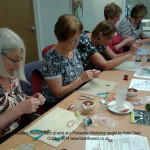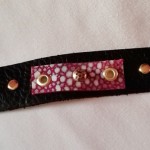Beading Classes: why you should attend one
Beading classes, books and magazines used to be the only way you could learn about beading techniques, tools and materials, but since the expansion of the internet, it is possible to learn from videos in your own home. Does this mean that beading classes will become a thing of the past?  I do hope not. I keep hearing reports of beading classes struggling to run or find enough people to make them viable, which is entirely understandable in an environment where people have less disposable income to spend. So, if your pennies are precious, it surely makes more sense to spend them on buying beads and using YouTube and other resources as a substitute for beading classes doesn’t it?
I do hope not. I keep hearing reports of beading classes struggling to run or find enough people to make them viable, which is entirely understandable in an environment where people have less disposable income to spend. So, if your pennies are precious, it surely makes more sense to spend them on buying beads and using YouTube and other resources as a substitute for beading classes doesn’t it?
Well, actually it doesn’t necessarily. I am very used to teaching beading classes and incredibly grateful to the regular students who keep coming back to learn from me, but last Monday I was unexpectedly reminded of what it is like to be a student again and why a class is so essential. I had taken a trip to the NEC, Birmingham to the Craft, Hobby and Stitch International trade show. I had a list of people that I had arranged to meet there, one of them being Steven Weiss at the Beadsmith stand. As soon as I arrived, Steven said, ‘there’s someone I have to introduce you to, Melissa Cable.’ It turns out Melissa is a well-established artist who started working with metal and then moved on to leatherwork. She has published three books and she was with the Beadsmith stand because she has just been working with them on a new product: a complete leather working toolkit. As Melissa explained, this has been developed to give a beginner the full range of basic tools they will need, all of a high quality and at a reasonable price point.
I then had an impromptu  In that class Melissa gave me a quick guide to the toolkit, using each type of tool, so by the end of an hour I had a wearable bracelet. I had learned how to make holes in leather, learned that I needed different holes or piercing types depending on what I planned to set. I had set eyelets and rivets and a snap fastener and learned how to cut leather to size. This was a whirlwind lesson in which my brain was asked to absorb an enormous amount of information in a very short space of time, but I left feeling inspired and also reminded of just why there is really nothing to replace beading classes.
In that class Melissa gave me a quick guide to the toolkit, using each type of tool, so by the end of an hour I had a wearable bracelet. I had learned how to make holes in leather, learned that I needed different holes or piercing types depending on what I planned to set. I had set eyelets and rivets and a snap fastener and learned how to cut leather to size. This was a whirlwind lesson in which my brain was asked to absorb an enormous amount of information in a very short space of time, but I left feeling inspired and also reminded of just why there is really nothing to replace beading classes.
I know that Melissa is going to be recording a series of videos for the Beadsmith, demonstrating how to use the tools, so there is no reason why I couldn’t use those to find my way around my new toolkit. However, sitting there with Melissa watching me work and guiding me, I got tips that were applicable to me. Yes, a good video tutorial will give general tips for making life easier when you are learning any new technique, but it is only by having a teacher watch you and work with you that you will get tips that are really helpful to you personally. Melissa was able to immediately correct my mistakes, like the way I held the hammer, so that I didn’t get into a bad habit that will be harder to correct later on. I could ask questions when something didn’t quite make sense.
Beading classes also enable you to learn a much wider range of tips than a video. I believe that videos have a very valuable place: when Melissa’s are available I’m sure I will be consulting them to check on the bits that I’ve forgotten from the class. Equally, if I had no way of meeting Melissa in person, the videos would be the next best thing. However, imagine the scenario where I had bought my new toolkit and was working my way through it, consulting the videos to learn how to set an eyelet or find out what the splayer head was for. Well, I would have missed out on the whole conversation that Melissa and I had about design principles. How do you incorporate leather into beadwork or beads into leatherwork and why would you want to? I also know from my own experience of teaching beading classes that the conversation always ends up wandering on to the most tangential subjects. I might be teaching a class on French beading and end up explaining a tip for getting good tension in bead-weaving simply because one of the students mentioned they were learning a new bead-weaving technique. Every teacher has a wealth of experience and a range of tips in so many different areas. Only by talking to those teachers face to face at beading classes do you really get to access their knowledge and gain those helpful hints that will make your life easier.
 Finally, there is nothing like the companionship of a day spent doing something you love with people who share that passion. I have made great friends at beading classes – people I would never have met otherwise. Yes, I do make beading friends on Facebook and in the electronic environment, but it’s not quite the same as spending six hours together sharing the frustrations and achievements of working on a new beading project. So I hope that if you needed any persuasion as to why you need to go to beading classes, this has helped.
Finally, there is nothing like the companionship of a day spent doing something you love with people who share that passion. I have made great friends at beading classes – people I would never have met otherwise. Yes, I do make beading friends on Facebook and in the electronic environment, but it’s not quite the same as spending six hours together sharing the frustrations and achievements of working on a new beading project. So I hope that if you needed any persuasion as to why you need to go to beading classes, this has helped.
I’ve spent my week playing w ith my leather toolkit and created a leather clasp for a free-form bracelet. I even wrote up the pattern, so you can find a free download for that here. In between all that playing (it was actually work as I will be talking about leatherwork in issue 63 of Bead Magazine!), I also found the time to get everything ready for the next of my own beading classes tomorrow. So I shall be going from student to teacher this week and know I will be learning an enormous amount and having fun along the way.
ith my leather toolkit and created a leather clasp for a free-form bracelet. I even wrote up the pattern, so you can find a free download for that here. In between all that playing (it was actually work as I will be talking about leatherwork in issue 63 of Bead Magazine!), I also found the time to get everything ready for the next of my own beading classes tomorrow. So I shall be going from student to teacher this week and know I will be learning an enormous amount and having fun along the way.











